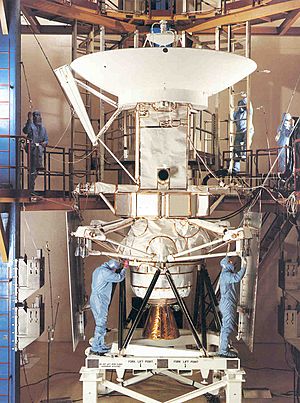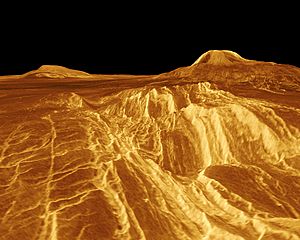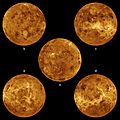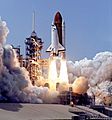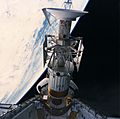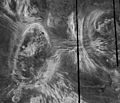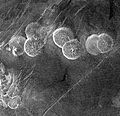Magellan (spacecraft) facts for kids
The Magellan spacecraft, also known as the Venus Radar Mapper, was a special robot explorer sent by NASA to study the planet Venus. It launched on May 4, 1989, and reached Venus on August 10, 1990. For four years, Magellan orbited Venus, using radar to create detailed maps of its surface and measure the planet's gravity. Because Venus has a very thick atmosphere that hides its surface, Magellan's information gave scientists their first clear look at what Venus really looks like. On October 12, 1994, the Magellan spacecraft was guided to crash into Venus on purpose, ending its mission.
Magellan was the first spacecraft ever launched from a Space Shuttle, specifically the Space Shuttle Atlantis. It was also the first spacecraft to be deliberately crashed into a planet. Interestingly, Magellan was built using parts left over from other space missions, including the Voyager program.
The spacecraft was named after the famous Portuguese explorer, Ferdinand Magellan (1480-1521), who was known for leading the first expedition to sail around the world.
Contents
Exploring Venus with Radar
The main goal of the Magellan mission was to map the surface of Venus. Venus is covered by thick clouds that make it impossible to see its surface with regular cameras. To get around this, Magellan used a special kind of radar.
How Radar Mapping Works
Radar works by sending out radio waves. When these waves hit something, they bounce back to the spacecraft. By measuring how long it takes for the waves to return and how strong they are, scientists can create detailed images of the surface below. This is similar to how bats use sound to "see" in the dark. Magellan's radar allowed it to "see" through Venus's thick clouds.
Mapping the Surface
Magellan completed several cycles of mapping Venus. Each cycle involved the spacecraft orbiting the planet and scanning its surface with radar.
- The first cycle, from September 1990 to May 1991, mapped about 84% of Venus's surface.
- The second cycle, from May 1991 to January 1992, mapped another 83% of the surface, helping to fill in gaps and get different views.
- The third cycle, from January 1992 to September 1992, collected even more data, including stereo images that helped scientists create 3D views of the landscape.
Measuring Gravity
After its main mapping mission, Magellan also spent time measuring Venus's gravity.
Understanding Gravity on Venus
Gravity is the force that pulls things towards a planet. By carefully tracking Magellan's orbit, scientists could detect tiny changes in its speed. These changes showed where Venus had stronger or weaker gravity. Areas with stronger gravity often mean there is more mass underneath, like mountains or dense rock. This helped scientists understand what was beneath Venus's surface.
The End of the Mission
After four years of successful exploration, the Magellan mission came to an end.
Crashing into Venus
On October 12, 1994, NASA decided to crash Magellan into Venus. This was done on purpose to learn more about how spacecraft behave when they enter a planet's atmosphere. Scientists wanted to see how the spacecraft would break apart and burn up. This information was important for designing future missions that might need to land on or enter other planets. Magellan sent back data almost until the very end, providing valuable information about Venus's upper atmosphere.
Images for kids
-
Five global views of Venus by Magellan
-
Launch of STS-30 on May 4, 1989
-
Maxwell Montes, highest point on Venus
See also
 In Spanish: Magallanes (misión espacial) para niños
In Spanish: Magallanes (misión espacial) para niños


